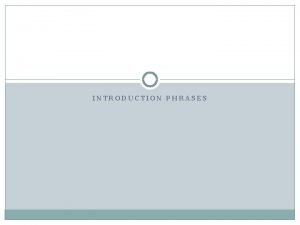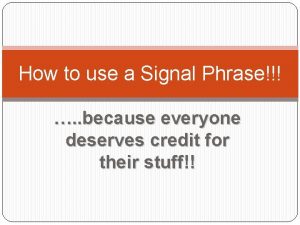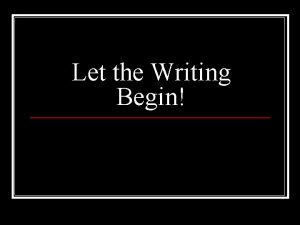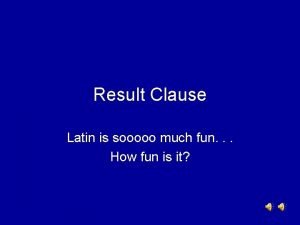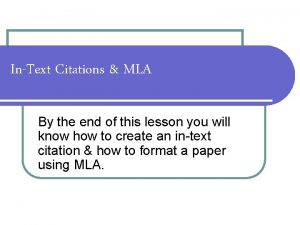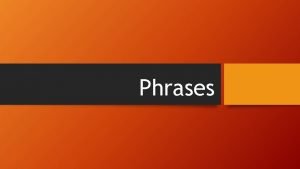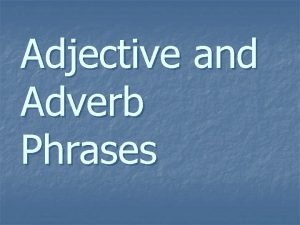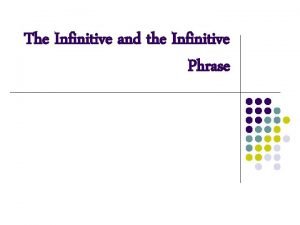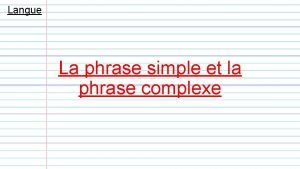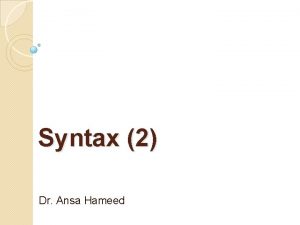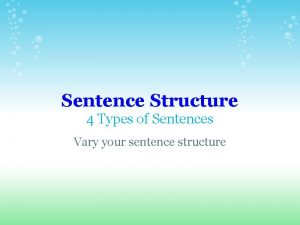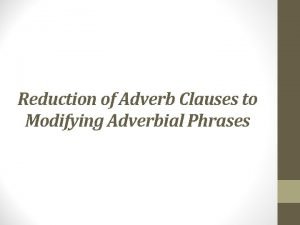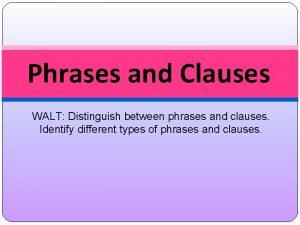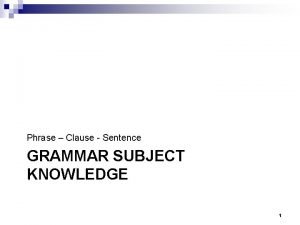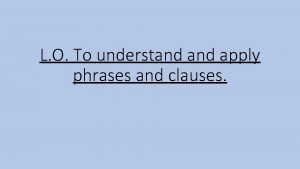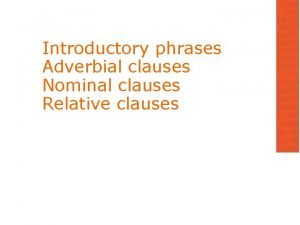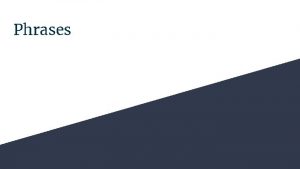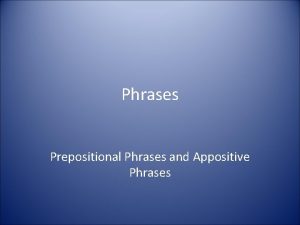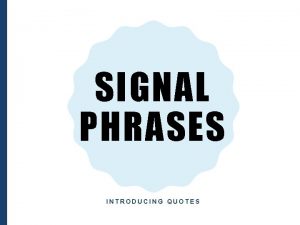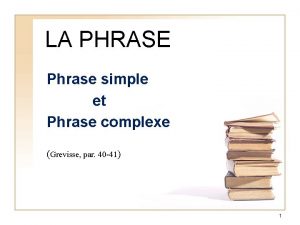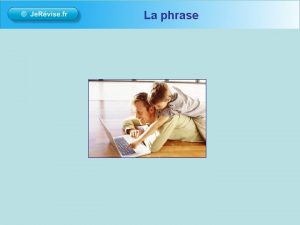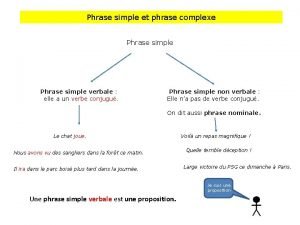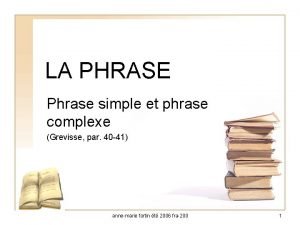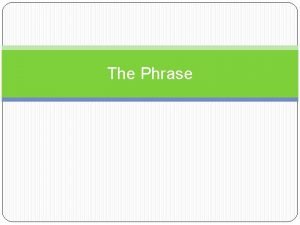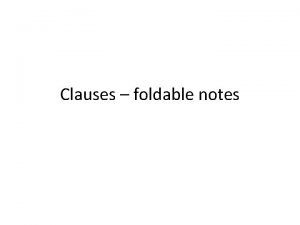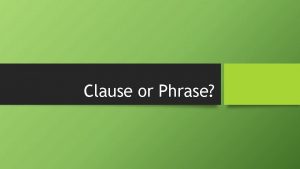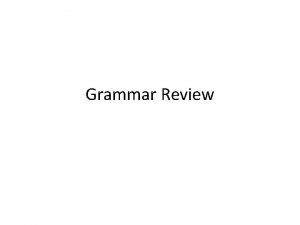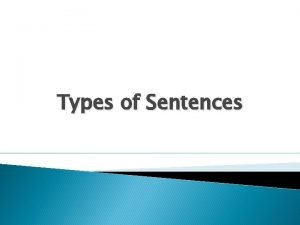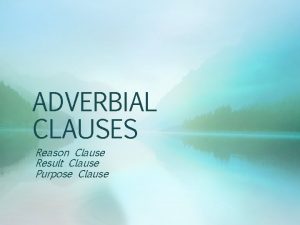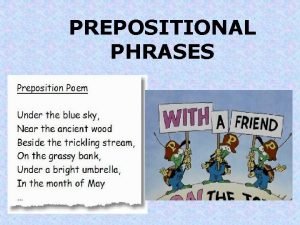INTRODUCTION PHRASES Signal phrases Phrase or clause the





























- Slides: 29

INTRODUCTION PHRASES

Signal phrases Phrase or clause the introduces a source A signal phrase distinguished your voice from that of the source A signal phrase clarifies who is speaking A signal phrase and the in-text citation isolates the borrowed material from your commentary It establishes your credibility as a writer.

Use a signal phrase or clause or sentence that Includes the author’s full name Provides the title of the work Example: P. D. James, in her book Talking About Detective Fiction, explains why the crime of choice is usually murder. She writes, “murder remains…” (James 11).

According to John Ball, in his article “Murder at Large, ” he writes, “…” (Ball 2). Deane Kelly, in her introduction to The Longman Anthology of Detective fiction, discusses…

Use signal phrases when continuing to use material from the source. Examples: James further explains… James insists….

Parenthetical Citations Ball writes, “The true detective story requires the reader to think. . . in the events as they unfold” (Ball 22). Note the placement of quotations marks The parenthetical citation The period

Writers use quotations for a variety of purposes: to argue with another author’s definition of a term, to provide statistical evidence or testimony to validate a claim, or to present the reader with a statement we wish to refute or discuss in detail. If writers overdo and include too many quotations in a research essay, readers will form the negative impression that the authors of those sources are more authoritative than the writer of the research paper.

Writers should use direct quotations only when the source’s words are particularly relevant, powerful, and/or an extremely representative example of that specific author’s thinking. A good policy is to use short quotes (about 25 words) and otherwise summarize or paraphrase sources whenever possible.

When quotations are included, they should be an integral part of the text—a vital part of the discussion. Some warning signs that indicate a writer has lost control of his/her quotes include the following:

The Salting Syndrome: If a reader can remove the quotes that have been “sprinkled” through the paper and still understand the essay, then the quotes are not an integral part of the essay and do not further the argument.

The Overpowering Opinion: If each paragraph begins with a quotation, the writer’s voice will be lost as the powerful opinion of an “expert” occupies the slot in which readers often expect to find a focus statement that organizes the information to be presented in that paragraph.

The Dreary Design: If each quotation is introduced using the same sentence structure and the same verb to indicate the author’s opinion, readers will quickly become bored with the presentation and tune out the writer’s message.

Block quotes Indent each paragraph ½ inch, but indent lengthy quotes (more than four lines) one full inch from the left hand margin: Remember that when you indent this way you do not need to enclose the quote in quotation marks. Keep in mind that this kind of quote does not stand alone but should be part of the sentence that introduces it. Also, stylistically you shouldn’t over use block quotes—try to put quotes in your own words (Author 1). If you must use a block quote, you can only use ONE in your final paper

1. Introduce the quotation with a complete sentence and a colon. Exam: In “Study: Over 68% of students use social media in internship search, ” Michael Schramm states directly how students used social media to find internships: "49. 2% of students used it to research employees, 46. 2% of students used it to network and 24. 5% used it to discuss internship opportunities” (Schrammm 3).

Use an introductory or explanatory phrase, but not a complete sentence, separated from the quotation with a comma. Example: In “Study: Over 68% of students use social media in internship search, ” Michael Schramm states, "49. 2% of students used it to research employees, 46. 2% of students used it to network and 24. 5% used it to discuss internship opportunities” (Schramm 3).

3. Make the quotation a part of your own sentence without any punctuation between your own words and the words you are quoting. Example: Schramm explains that "49. 2% of students used it to research employees, 46. 2% of students used it to network and 24. 5% used it to discuss internship opportunities” (Schramm 3).

4. Use short quotations--only a few words--as part of your own sentence. Example: In “Study: Over 68% of students use social media in internship search, ” Michael Schramm states "49. 2% of students” referred to social media to research employers (Schramm 3).

Notice that there are only two punctuation marks that are used to introduce quotations: the comma and the colon (: ). Note that a semicolon (; ) is not used to introduce quotations.

Introducing quotes The author says. . . The author reveals. . . The author notes. . . The author expresses. . . The author believes. . . The author states. . . The author observes. . . The author mentions. . . The author comments. . . The author acknowledges. . . The author relates. . . The author suggests. . . The author declares. . . The author thinks. . . The author remarks. . . The author points out. . . The author discusses. . The author responds. . . The author reports. . . The author shows. . . The author explains. . . The author confirms. .

Direct quotes cont. If you are quoting a passage that contains a quotation, then you use single quotation marks for the internal quotation. Here’s an example of a quotation within a quotation: Ex. In “The Emperor’s New Clothes, ” Hans Christian Andersen wrote, “‘But the Emperor has nothing on at all!’ cried a little child” (Anderson).

Ellipsis Whenever you want to leave out material from within a quotation, you need to use an ellipsis, which is a series of three periods, each of which should be preceded and followed by a space.

Few rules to follow using ellipses: 1. Be sure that you don’t fundamentally change the meaning of the quotation by omitting material.

Take a look at the following example: “The Writing Center is located on the BC campus and serves the entire BC community” (Author 1). “The Writing Center. . . serves the entire BC community” (Author 1). The reader’s understanding of the Writing Center’s mission to serve the BC community is not affected by omitting the information about its location.

2. Do not use ellipses at the beginning or ending of quotations, unless it’s important for the reader to know that the quotation was truncated. For example, using the above example, you would NOT need an ellipsis in either of these situations: “The Writing Center is located on the UNC campus. . . ” (Author 1). The Writing Center “. . . serves the entire UNC community” (Author 1).

We covered various ways to introduce quotes The first time a source gets introduced, the signal phrase needs to come first. Any other time you refer to the same source, the signal phrase can be used in the middle or end of a quote.

Interrupt the quote with an attribution to the speaker. Again, you will need to use a comma after the verb, as well as a comma leading into the attribution. “There is nothing either good or bad, ” Hamlet argues, “but thinking makes it so” (Hamlet 2. 2). “And death shall be no more, ” Donne writes, “Death thou shalt die” (“Death, Be Not Proud, ” l. 14).

The signal phrase can follow the direct quote: Example: “There is nothing either good or bad, but thinking makes it so, ” Hamlet argues (Hamlet 2. 2). “Language is a process of free creation, ” claims Chomsky ( ).

Author: Denise Chow Name of article: Giant Iceberg Breaks Off Antarctic Glacier Quote: A massive iceberg, larger than the city of Chicago, broke off of Antarctica's Pine Island Glacier on Monday (July 8), and is now floating freely in the Amundsen Sea

Source: Title: Immigration reform would boost state’s tax Newspaper: The New Mexican By: Adele Oliveira Quote: A study released Wednesday by the Institute on Taxation and Economic Policy says comprehensive immigration reform would increase New Mexico’s annual tax revenue by $6 million and national tax revenue by $2 billion.
 Baseband signal and bandpass signal
Baseband signal and bandpass signal Baseband signal and bandpass signal
Baseband signal and bandpass signal Digital signal as a composite analog signal
Digital signal as a composite analog signal The product of two odd signals is:
The product of two odd signals is: Whats a signal phrase
Whats a signal phrase Signal words for introduction
Signal words for introduction Whats a signal phrase
Whats a signal phrase Signal phrase
Signal phrase Signal phrase verbs
Signal phrase verbs Result clause in latin
Result clause in latin Indirect quotation
Indirect quotation Signal phrases
Signal phrases Signal phrases
Signal phrases Phrase and its types
Phrase and its types Adjective phrase and adverb phrase
Adjective phrase and adverb phrase Infintive phrase
Infintive phrase Phrases graphique
Phrases graphique Phrase juxtaposée exemple
Phrase juxtaposée exemple Expanded noun phrase with prepositional phrase
Expanded noun phrase with prepositional phrase Transformer une phrase verbale en phrase nominale exemple
Transformer une phrase verbale en phrase nominale exemple Whats a absolute phrase
Whats a absolute phrase Phoneme vs morpheme
Phoneme vs morpheme Difference between clause and phrase
Difference between clause and phrase 4 types of sentence structure
4 types of sentence structure Reducing clauses to phrases
Reducing clauses to phrases Difference between phrase and clause
Difference between phrase and clause Sentence vs phrase
Sentence vs phrase Clause and phrase difference
Clause and phrase difference Phrases and clauses with examples
Phrases and clauses with examples Phrase vs clause
Phrase vs clause





